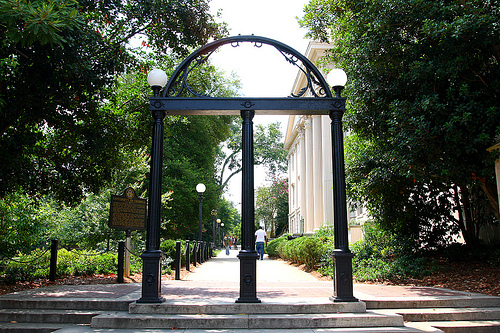By: Shalin Jyotishi

Every year, millions upon millions are spent on the University of Georgia’s research enterprise. Since the enactment of the Morrill Act of 1862, the University of Georgia has served as the state’s land-grant, sea-grant research university. UGA has a duty to conduct meaningful research to benefit the citizens of the state, nation, and world. Prestige, recognition, and public and private support all stem from a powerful research enterprise. Among the most elite public research universities – University of Michigan, University of California-Berkeley, UCLA, UNC-Chapel Hill, University of Virginia, and many others – a vibrant, thriving research portfolio stands as the common denominator. Faculty who can obtain competitive National Science Foundation (NSF) and National Institute of Health (NIH) grants are deemed deserving of accolade in their respective fields. Institutions with the most cutting-edge facilities are able to attract the attention of businesses, and political and academic leaders all around the world. Undergraduate and graduate students flock to universities to utilize research capacities for their professional development.
However, one of the most crucial aspects of university research has to be the potential for revenue, and that notion is understood at UGA. Over the past 35 years, more than 500 new products based on UGA discoveries have been released into the world. One would be hard-pressed to find the average student, parent or football fan knowing that UGA created turf grass (called TifSport or TifGrand) which is now used everywhere from lavish golf courses in Dubai to the FIFA soccer stadiums in Brazil and South Africa. 95 percent of Georgia’s $980 million peanut crop has been UGA-improved. 55 percent of blueberries grown in the state have been affected by the research taking place in Athens. Would you believe UGA has been ranked in the top five universities in the nation for total licenses and options for the past six years? UGA is ranked in the top 15 among public universities in licensing revenue and top 40 among all universities. UGA garnered $8.3 million dollars in fiscal year 2013 thanks to the licensing revenue stemming from faculty work. These dollars and products are the outcomes of technology transfer, which is the process by which a university takes the work done by a faculty member and licenses it for commercial use in the business sector.
To learn more about tech transfer, I sat down with Dr. Derek Eberhart, Director and Chief Licensing Officer of UGA’s Technology Commercialization Office.

GPR: Tell us about yourself. How did you get in the position you are today?
Eberhart: I’m a UGA graduate, I got my undergraduate and master’s here at Georgia. I was raised in the South. My master’s and undergraduate degrees are in poultry science and poultry genetics. I went to Emory University for my PhD in molecular genetics where I focused in human disease. My post-doc was at St. Jude’s Children’s Hospital where I did cancer research. At the time, I thought I’d go into academic research, but I had a friend who had a start-up company down in Texas, now called Lexicon Pharmaceuticals. As the company grew, we developed relationships with other bigger companies like Bristol-Myers Squibb and a number of others. I moved into alliance management, licensing, and business development. It was great working in business with a science background. We also worked with the NIH and different non-profit agencies. I had some former colleagues who moved into academic tech transfer. I had always been interested in coming back to UGA. My wife and I both graduated from here, and we both loved Athens. This position opened up about five years ago, and I took the opportunity. It was great working with faculty members, intellectual property protection, companies, and other groups.
GPR: How has technology transfer changed over the years?
Eberhart: From a university perspective, it’s a fairly new profession. Back in 1980 the Bayh–Dole Act was really what changed how universities were involved in commercialization. It allowed recipients of federal grant money to be able to actually elect ownership to an invention they make using grant money. Before that, the government was in charge of the procedure. Around 1980, the University of Georgia Research Foundation was created. They’re basically the stewards of all the [inventions and innovations] created by UGA employees. Technology transfer at UGA has increased tremendously over the last thirty years. Universities are looked to more as stimulants for economic development. We have research, teaching, and service as the main mission components of a university, and tech transfer fits into the research category. I think the concept of tech transfer has expanded over the years, and I think a lot of companies are scaling back research and development especially in the pharmaceutical industry where I came from. [The pharmaceutical companies] are looking to partner with research universities and tap into their innovation pipelines rather than doing it all in-house.
GPR: What are the relationships between faculty and administrators when it comes to technology transfer? Tech transfer can be a good source of revenue for the university, but you also have to factor in the “publish or perish” mentality of many faculty. How does that play into tech transfer?
Eberhart: We try to have more of a service approach. We’re here to serve faculty. I think a lot of faculty members see the satisfaction of something they have developed in their lab actually move from the lab into the market place. We try to take away as much of the administrative burden as we can and really allow the faculty members to focus on the research piece. If there’s no great research being done at the university, there’s nothing for the tech transfer office to do … as a part of our service to the community, some of the proceeds go back to the inventor, but the vast majority goes back to the research enterprise. The money that comes out of intellectual licensing goes back to research to reinvest in research.
GPR: What are some of the differences between public and private tech transfer offices?
The big distinction is private universities don’t necessarily have a service ambition, which is a big part of public universities. A lot of [private universities] focus on a revenue model. They might focus on what’s going to bring in the most revenue as opposed to focusing on the other opportunities that might not bring in as much money but are still beneficial. For UGA, our land-grant status gives us that obligation to create technologies that can benefit the public. Even if the return will be marginal, if it’s something that can benefit the public, we’re more likely to move forward with that and proceed with the tech transfer process. I think you can see that with the 500 products coming out of the [University of Georgia] over the last 35 years. Some of those aren’t going to make a lot of money, but some of them do make a lot of money. We recently developed a milk cooler that doesn’t require electricity. These types of things aren’t going to bring much money back to the university, but it helps meet a global need.
GPR: Where is UGA headed as far as tech transfer is concerned? What’s in the pipeline for UGA?
Eberhart: The expansion of the engineering school is very exciting. We’ve always had engineering here as part of the College of Agriculture and Environmental Sciences. Now it’s a stand-alone college, which is expanding the scope of its research. We’ll see many new products coming from them and collaborative projects. The Center for Molecular Medicine is also something that fits with the tech transfer model. The key to our tech transfer program is the breadth of the portfolio. We’re also looking to expand industry-sponsored research which might support early stage research that could lead to new products or technologies.
GPR: What would you tell the average student or alum interested in knowing what their university’s Technology Transfer Office needs to continue flourishing and expansion? Does UGA need more fundraising, more graduate students, more faculty members?
Eberhart: I think an awareness of what’s taking place at the university and helping to spread the word would be the biggest thing. [If the students asked each other], “Did you know there are over 500 products coming out of the university?” “Did you know the university’s tech transfer program is consistently ranked in the top five in terms of the number of licenses” that awareness would really help. I also think we need to tap into our pool of alumni who are out there in the business world who might be interested in starting a company around UGA technology or maybe they’re in a company now that can benefit with working with UGA. There are a lot of those stories that I don’t think are known enough. If you see a cool UGA story, pass it along!
GPR: Who is the current “industry model” for technology transfer, and what are we doing to replicate what they’re doing?
Eberhart: The Association of University Technology Managers (AUTM), which is the professional organizations for academic tech transfer, put out a survey every year. Our operation actually compares very favorably across the US. We’re top 15 for revenue and top 40 overall. I think it’s important to benchmark with peer institutions. We have to look at the research portfolio of a university. For example, UGA doesn’t have a stand-alone medical school and our engineering school is also new. We recently visited University of Florida’s tech transfer office as a benchmarking exercise. They have a really strong tech transfer program, but about 50 percent of their inventions come from their medical school and 25 percent from engineering. It’s hard to compare without controlling for that. We’re also in contact with other state research universities for benchmarking.
GPR: In a previous GPR interview, UGA Director for State Relations, Tricia Chastain, noted that Georgia is one of three states to house more than one top 20 public universities. What is your perception of prestige or rankings for research and tech transfer?
Eberhart: I think you pursue research excellence and rankings follow that. I don’t think it makes sense to chase rankings. Georgia does have a lot of strong universities. We have a great breadth of portfolio that’s not seen at other universities, but we also have the advantage of being close to Emory, Georgia Tech, Georgia State and Georgia Regents isn’t too far away. We have this “research crescent” that models after the research triangle in North Carolina (formed by Duke, UNC-Chapel Hill and North Carolina State University).
It goes back to the role of a university in economic development. Universities produce a lot of what companies need to invest, such as access to top graduates and access to innovation and expertise. For example, our Complex Carbohydrate Research (CCRC) facility is a world-renowned facility. Companies move to Georgia to make use of facilities like the CCRC, for example, Galectin Therapeutics. In the end it benefits the university and the state. We can attract top graduate students, top faculty, top undergraduates.
GPR: The Association of American Universities (AAU) is an invite-only association of 62 elite research universities. When Georgia Tech was admitted in 2010, an article from the Chronicle of Higher Education cited UGA as a possible future member of the AAU. Does technology transfer have a role in obtaining “AAU status”? Is this something on your office’s list of long-term goals?
Eberhart: It is something that’s part of the overall master plan for the university. In terms of honors, we recently received a designation from the Association of Public and Land-grant Universities (APLU) as one of 16 Innovation and Economic Prosperity Universities, which was given to institutions who significantly contribute to state economic development. National and international reputation is definitely one aspect for the office.

